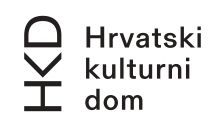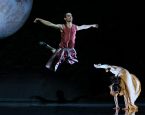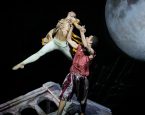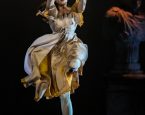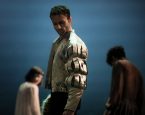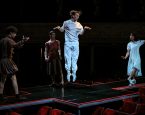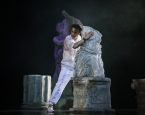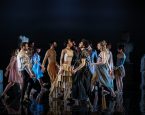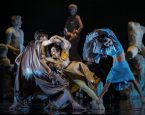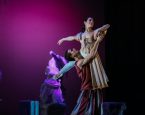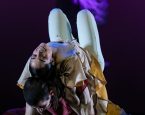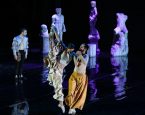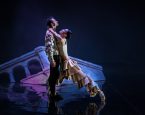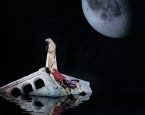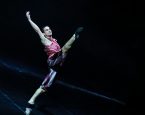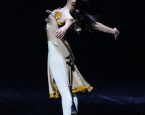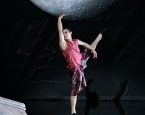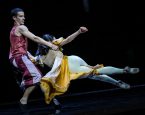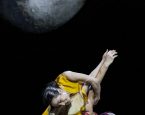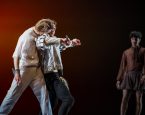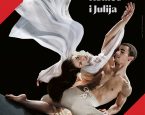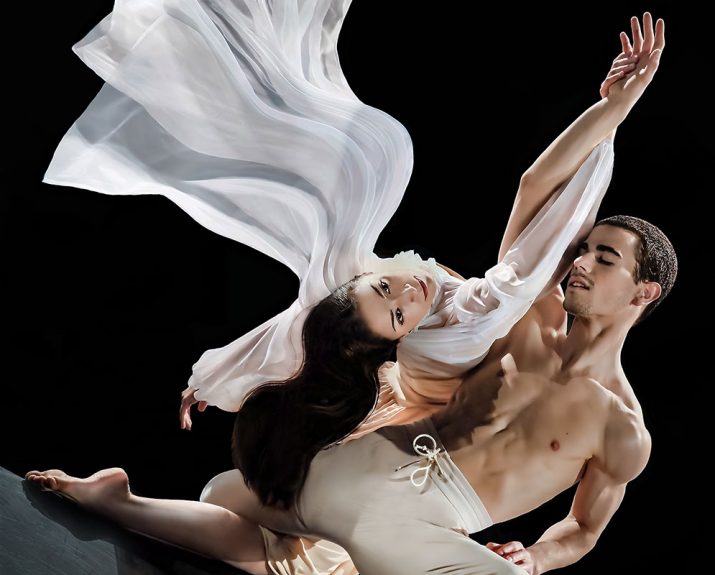
Premiere ROMEO AND JULIETSergej Prokofjev
Riječki simfonijski orkestar
In collaboration with the Rijeka Symphony Orchestra, Croatian Drama and Italian Drama
Special thanks to:
Translator Mate Maras for use of his translation of William Shakespeare’s play Romeo and Juliet;
Matica Hrvatska for the use of the electronic edition of the classics of world literature, 2011
Director Edvin Liverić and the technical staff of the Croatian Cultural Centre in Sušak for the provided space and assistance for rehearsals of the show.
Romeo and Juliet perfectly capture the rush of being in love and the desire to make that feeling last forever despite daunting circumstances.
The story is often thought to be about love and it’s power. But actually the audience fails to realise that the love is included in the piece only in a few fragile moments of satisfaction. The theme of the play becomes mainly about violence and chaos, confusion and death. From the very beginning of the play it is highly evident that violence will occur. Furthermore the needlessness of the deaths in society, especially since it predominantly happens amongst youth.
The story teaches one of letting old family wounds go, and not letting your emotions rule your life. The Montague and the Capulets have let an old family rivalry take away the future of their own children. It is a narrative that expresses a historical conflict between old forms of identity and new modes of desire, between authority and freedom, between parental will and romantic individualism.
The performance lasts approximately two hours and is performed with one intermission.
1st Act
Members of the Capulet and Montague households are caught fighting in the streets. The Prince Escalus proclaims to Lord Capulet and Lord Montague that ‘If ever you disturb our streets again, / Your lives shall pay the forfeit of the peace’.
Lady Montague asks Benvolio to cheer up Romeo who is troubled thinking of Rosalind.
Mercutio comes with 3 invitations to Capulet ball. Romeo hesitates, but later he agrees to join his friends Benvolio and Mercutio go to the Capulet ball even though they are Montague.
Mercutio is frustrated with Romeos feelings of love to Rosalind and starts to talk of love fairy “Queen Mab”. Romeo thinks that Mercutio is getting too far and that he talks of nothing.
Capulets’s and Montague’s hate to each other is so strong that it is always presented.
Paris asks Lord Capulet for Juliet’s hand in marriage but Lord Capulet feels she is too young. Lord Capulet decides to invite Paris to a ball instead so he can win Juliet over.
Juliet promises her mother, Lady Capulet, and her nurse that she will ‘look to like’ Paris when she meets him at the ball.
Romeo and Juliet meet at the ball and are instantly attracted to each other. They kiss each other but soon discover the other’s true identity, with Juliet declaring ‘my only love sprung from my only hate’.
Tybalt sees Romeo at the ball and is so offended he vows to seek revenge. Mercutio saves the situation by taking attention on himself and making fun of Tybalt. But Tybalt doesn’t stop. He gets in fight with Lord Capulet. Lord Capulet shows that he is the master of his house and won’t tolerate Tybalt behaviour.
Romeo hides in the Capulets’ orchard to try and catch a glimpse of Juliet. He sees her at her balcony and listens while she talks about him. He reveals himself and tells her he feels the same. They declare their love for each other and talk about marriage.
2nd act
Romeo visits Friar Laurence and asks the Friar to marry him and Juliet. At first Friar Laurence refuses but then thinks this may be a way to end the feud between the two families.
The Nurse goes to find Romeo to send the message from Juliet regarding their plans of marriage. Nurse is asking Romeo what his intentions are towards Juliet. He assures her they are honourable and that Juliet should visit Friar Laurence that very afternoon.
Juliet waits impatiently while the Nurse gives her the news about her marriage to Romeo.
Romeo and Juliet are married in secret.
On the street a fight breaks out between Romeo’s friend Mercutio and Tybalt but, when Romeo tries to stop it, Mercutio is stabbed and dies. Mercutio curses both the Capulet and Montague houses, saying ‘A plague o’ both your houses!’. In revenge, Romeo kills Tybalt. As punishment, the Prince Escalus banishes Romeo from Verona.
Juliet waits for Romeo for their first night together, but discovers he has killed Tybalt. At first she curses his name, but soon realises she still loves him and wants to see him. The Nurse agrees to get him for her.
Romeo secretly visits Juliet in night. They say goodbye to each other and he leaves for Mantua.
Juliet is then given the news about her marriage to Paris. When she refuses to marry, Lady Capulet threatens to disown her, calling her a ‘disobedient wretch’.
Paris asks Lord and Lady Capulet for Juliet’s hand in marriage again. This time he agrees and they set the wedding date for a few days’ time.
Juliet tells Friar Laurence she will kill herself rather than marry Paris. He gives her a potion that will make her appear dead. They plan for her to take it and be placed in the Capulet family tomb. Friar Laurence will send for Romeo and he can meet her there when she wakes up.
Juliet tells her mother and father she is sorry for disobeying them and agrees to marry Paris. They are both overjoyed and move the date of the wedding forward.
Juliet takes the potion Friar Laurence gave her, saying “Farewell! God knows when we shall meet again”, and immediately falls down as if dead.
Juliet’s body is discovered and, as planned, is taken to the tomb.
Friar Laurence doesn’t manage to deliver in time to Romeo the message about Juliet’s death being faked. Friar Laurence worries Romeo will hear the false news and runs to the tomb to be there before any disaster may happen.
While in Mantua, Romeo discovers that Juliet has died. He travels fast back to Verona.
Romeo goes to Juliet’s tomb where he disturbs Paris, who is mourning for her. They fight and Paris is killed. Romeo takes poison and dies. Friar Laurence arrives and tries to get Juliet to leave with him, but Juliet asks for private time to say good bye to Romeo. Friar Laurence is worried but agrees. When he leaves, Juliet kills herself with Romeo’s dagger.
In our ballet we follow the Shakespeare’s play Romeo and Juliet with all the main characters and their relationships. But as well the incredible music by Sergei Prokofiev wonderfully written specially for this story. Our concept and our intention is to bring the audience as closest possible to the to the story and to all the performers. The scenery, therefore, goes beyond the stage to the auditorium, where we build a bridge over the seats which symbolises the family division, but as well the connection. The stage in the audience has a shape of a cross as metaphor to the destiny that they have to carry. Dancers are not only dancing on the life orchestra in the pit of the theatre, but as well dancing on Shakespeare’s text spoken by two actors. The story happens on stage, between spectators and on the bridge.
This production is strongly guided by the Play of Shakespeare. Through the clues we found in the text we defined how the characters are and their relationships. The way the production is going to look was motivated by the idea of combining together multiple artistic aspects as dance, theatre, film and music.
It is a play about love and violence, a type of violence that we can still observe on the streets around us now. A world where wars are on and on constantly among neighbours countries all over our planet. This way the play feels very relevant to our times and its amazing because it was written 400 years ago. And like in Shakespeare times, these wars are like closed circles between two sides defined by honor and shame for decades. And the only way out is the death of innocent children and young people.
Those older generations hypnotised by their historical wounds dictates to new innocent generations what to do, but then their children’s reaction comes as a strong impact, exactly like a boomerang backwards to the older generation with extreme events. All is leaded by passionate blind decisions with mistaken results that is powerless in face of the fate.
Shakespeare reminds us since then that perhaps a different type of parents are needed, more open, more able to listen, where generations will communicate better. And this is a play about revolution, when young people through their love and sacrifice are trying to make a change in their society.
The story is a huge mess of decisions and actions happen in a very short time of 4 days. Alternating between very violent scenes, followed immediately by love and new possibilities and situations full of all kinds of expectations.
While action unfolds it brings a lot of contrasts and emotions for the dancers to go through in one and a half hour. They have to stay open and receptive to what they have to go through and feel in the deep of their hearts the changes in the most truthful way. However, they can find a lot of support in the music. As the music of Prokofiev is very accurate with the story and contains all the emotional guidance in the amazing layers of melodies.
Prokofiev’s music has a huge fascination for me and I dare to say also for our orchestra as a collective. It’s so direct and at the same time complex in the way it transports all facets of emotions through sound. It can be playful, painful, powerful – all within just a moment. His Romeo and Juliet is definitely one of the best versions, the Shakespeare material has been set into tone. Using no words it leads with such clearness through the emotional journey. It is a joy to follow how Projofiev uses certain motifs and themes to give each character – or state of emotion – a specific brand that keeps returning throughout the piece. To work with our fantastic ballet company on this is a wonderful matter. Prokofiev wanted this piece to be performed with dancers after all! The music (the suites from the ballet) is performed in concert much more and constantly throughout the world. It’s a much rarer event to have the masterpiece performed in this originally intended way as a “Gesamtkunstwerk” of storyline, dance and music – only then it can unfold it’s full and universal impact.
When I was imagining the spaces for the ballet Romeo and Juliet,I was inspired by strong and gentle Prokofiev music,those characteristics are also visible in the drawings.
The space is filled with Renaissance pieces of fragile architectural forms that emerge from the ground or appear from above, which reminds us of some old ruins.
These forms are hanging in the metaphysical space, and represent pieces of memory, melted architecture of a dream.
In my design I often try to combine the contemporary with the historic. I want each character to be special and the costumes to communicate my ideas to the audience. I choose for this time a romantic direction. The costumes are quite fashionable with details from Renaissance period, are easy to wear and comfortable, in order to be able to support the movement and the story as much as possible.
The Rijeka Ballet is in the midst of extensive preparations for something new and grandiose! One of the most popular ballets of the 20th century, Sergei Prokofiev’s Romeo and Juliet, will soon appear before you – alongside actors and an orchestra!
What a privilege! The world-famous dance star Jiří Bubeníček is choreographing the ballet, which is presented in collaboration with the Rijeka Symphony Orchestra and the Croatian and Italian Drama companies, and based on a concept he devised with his wife Nadina Cojocaru, who is also responsible for the dramaturgy and costume design. Behind them is a long period of research, of composing and rearranging ideas and thoughts, as well as a lot of energy invested in artistic creations, which from every corner of the theatre will immerse the audience in the world of quarreling families full of hatred and the most in-love couple in history through “polished” dance, music and acting interpretation starting April 27.
From short scenes to abstract works, then to full-evening ballets with a story, Jiří Bubeníček is the creator of an impressive 60+ choreographies. Before that, he enjoyed huge acclaim in his 25-year career as one of the greatest ballet dancers in the world – it is a great achievement to have his work in the repertoire! His musicality, athleticism, unrivaled technique and instinctive sense of character is what made what he did special, because of which some of the greatest choreographic legends created choreographies especially for him. And now, a man with such experience is working with the Rijeka Ballet, with the creative support of Nadina Cojocaru.
While watching the choreographer work with the dancers at one of the rehearsals of Romeo and Juliet three weeks before the premiere, one could already conclude that this is a great, especially beautiful ballet, with tender and passionate duets, telling a story that is an emotional marathon. It was inspiring to watch his work with the dancers, to watch as the choreography “took hold” in the dancers’ bodies. It was a pleasure to hear the precise instructions that offer a whole new world for each character in each of the dancers, while they also create the characters from themselves. Between choreographing, Bubeníček motivates with stimulating energy to work hard, with healthy moments of humor and his great respect for the dancers, full of praise for the uniqueness of each member of the Ballet with Character.
And the cast is a perfect fit! When you see the duet between Romeo and Juliet, for example, how they intertwine, how they “merge” and “melt” into each other in amazing choreography, how they glide on the stage and hover with ease in their infatuation, beautiful bodies and energies, young, enthusiastic, so realistically committed to each other – you really believe them. The casting is very important to Bubeníček, especially when it comes to ballet that tells a story. The dancers are chosen according to the nature of the roles, and he helps them develop the assigned character from themselves. The process is infinitely interesting: from extensive conversations with the dancers to find that character in themselves through a series of questions, to try not to “act or overact, not to act as though they are moving in a ballet, but to break free and be simple, young people with certain desires, endeavors and thoughts that the character elicits from them,” until they have a reimagined interpretation the characters from Shakespeare’s play, conveying all their nuances. Bubeníček frees them from all learned, limiting tasks, reminding them to become aware of implicit biases and to use knowledge and experience in a new way.
When Jiří Bubeníček demonstrates a part of the choreography, in a short moment he completely assumes the attitude and personality of the character, so clearly that you fully recognize the character’s nature. His intention is not to impose his own way, but to provide a brief example. “The music is so beautiful; it’s beautifully composed. Listen to the music – it tells you everything,” says Bubeníček, fascinated by Prokofiev, searching for full presence and individual dramatic persuasiveness among the dancers.
Between choreography sessions, we managed to capture a moment for a short conversation:
You not only present this story in front of the audience, but also in a Shakespearean way – from among the audience.
With the story of Romeo and Juliet, we wanted to get closer to the audience, physically as well. That’s why we created a bridge in the auditorium; that’s why we have two actors – because when you listen to a story about something, you feel it more closely, more clearly. Dancers portray characters from words and music with dance. We wanted to give it all to the audience to make the impression stronger; instead of the usual order, there is none: the audience, the orchestra in the pit and then the dancers on stage. We wanted to tell a story from among the people.
What are your thoughts on a topic that has never ceased to be relevant, neither before Shakespeare’s time nor ever since?
The story is so familiar; the topic is so current. When you read Shakespeare, you realize that people haven’t changed. It’s more or less the same: the problems we have today, the difficulties, the search for ourselves, have been the same for centuries. Shakespeare talks about two families who hate each other. The same thing is happening in every country in Europe, the past full of family quarrels in which no one wants to forgive anyone. It is then passed down from generation to generation. Europe is small. Suddenly we have whole countries fighting against each other. Due to such tensions, suddenly no one knows what to do anymore, so they fight on. It’s so topical! It takes a lot of sacrifice to escape it. Here are young lovers who sacrifice their great love while their families are fighting.
What do you mean when you say you really give a place to Romeo and Juliet?
If we do not give younger generations a voice, if we force them to act like their parents, we are only educating them to fight against each other. Indefinitely so? Instead we give them whatever we can to develop emotional intelligence and learn about emotions and reactions.
Conversation with Andrea Labik

